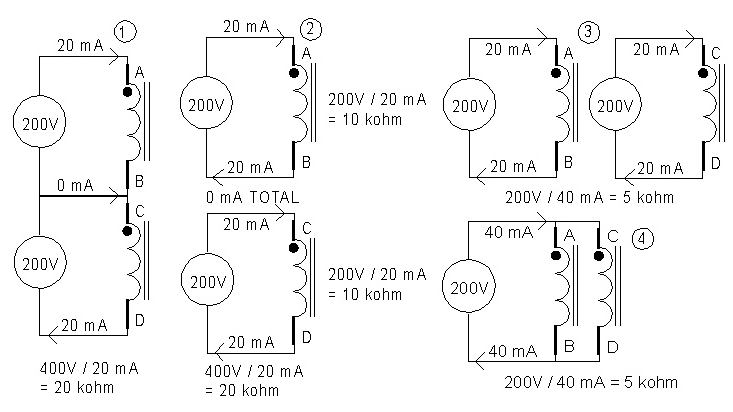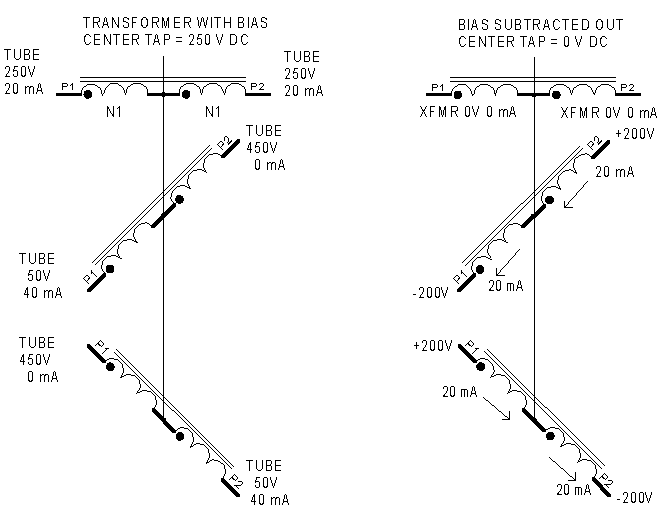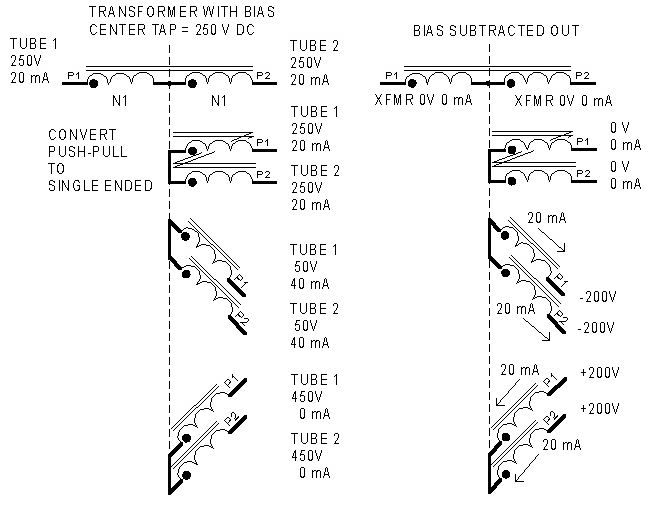Push-Pull Primary Impedance
Plus a few transformer notes
What I intend to show is that the effective impedance
(also called the composite impedance) seen by the pair of tubes in a push
pull amplifier is 1/4 the end to end plate impedance of the transformer.
From this we'll see that the load line seen by the each tube in a pair
of push-pull tubes depends on whether or not the tubes are biased class
A or class B.
Other sites that talk about this:
Pearl's
copy of the MIT's Theory on Push-Pull
Load
Lines Made Simple
Steve's
Bench on Composite Load Lines
The Basic Transformer Equations
Last Update 26-Sep-04
First we need to learn the basic ideal (loss
less) transformer equations:
1. The volts per turn on a leg
of a transformer are constant. This rule is independent of the direction
the current is flowing with respect to the dot.
1.2 V1 / V2 = N1 / N2
1.3 V2 = V1 * N2 / N1
2. The ampere turns into the transformer
must equal the ampere turns out of the transformer. This is simple energy
conservation. (Winding 2 must have the same volts/ turn as winding 1, but
winding 2 does not need to have the same amps as winding 1.)
For a two winding transformer this means
2.1 I1 * N1 = I2 * N2
Which becomes
2.2 I1 / I2 = N2
/ N1
or
2.2 I2 / I1 = N1 / N2
If N1 has more turns than N2, we get less
current on I1 (winding 1)
for a given current on I2 (winding 2).
2.3 I1 = I2 * N2 / N1
For more than two windings we get this equation
2.4 I1 * N1 = I2 * N2
+ I3 * N3 . . .
3. The transformer winding
impedance is V / I:
Z1 = V1 / I1
Z2 = V2 / I2
Now divide equation 1.2 divided by 2.2 to get the impedance
ratio
( V1 / I1 ) / (V2 / I2) = ( N1 / N2 ) / ( N2 / N1 )
= ( N1 * N1 ) / ( N2 * N2 )
= ( N1 / N2 )^2
3.1 Z1 / Z2
= ( N1 / N2 )^2
If N1 has more turns than N2, winding 1
has a higher impedance than winding 2.
4. In a low loss signal transformer,
we can usually ignore non-ideal behaviors. However, lets discuss a few
non-ideal transformer behaviors. Winding 1 is the drive winding for this
discussion.
4.1 The volts / turn is set by
the voltage on the drive winding after IR drop (Current * DC resistance)
is subtracted from the drive winding's voltage.
1.1a ( V1 - IR1 ) / N1
= V2 / N2
1.2a ( V1 - IR1 ) / V2 = N1 /
N2
1.3a V2 = ( V1 -
IR1 ) * N2 / N1
4.2 The actual voltage on the output
winding is the corrected volts / turn from 4.1 less the IR drop on the
output winding.
1.3b V2 = [ ( V1 - IR1
) * N2 / N1 ] - IR2
4.3 The amps into the drive winding
is ideal reflected load current from 2.1 above + the magnetization current
+ the core loss current.
2.3a I1 = I2 * N2 / N1
+ V1 /{ j * 2 * pi * F * Lpri } + [ Core loss watts / V1 ]
The "j" is to remind us that this is a
vector addition of currents. Remember, the core loss will be in phase with
a reflected "resistive" load current.
I1 = sqrt [ ( I2 * N2 / N1 + [Core loss
watts / V1] )^2 + ( V1 /{ 2 * pi * F * Lpri} )^2 ]
The Mathematical Push-Pull
Impedance Example
Last Update 26-Sep-04
If the secondary turns are N2 and the full primary
turns are 2 * N1, the impedance ratio from the full primary to the secondary
is (2 * N1 / N2 )^2 or 4 * (N1/N2)^2. The impedance ratio for one half
the primary is just (N1/N2)^2. The impedance of 1/2 the primary is
1/4 the impedance of the end to end primary. If the output load is 8 ohms
and N1/N2 is 25, then 8 ohms * (N1 / N2)^2 is 5000 ohms.
If tube 1 (P1) is removed, the impedance seen by
tube 2 on primary 2 (P2) is (N1 / N2)^2. This is 1/4, not 1/2, the end
to end primary impedance. This makes sense, the output power to the load
hasn't changed, the P1 winding isn't contributing to supporting the output
load and P2 must support the full output load. If P1 is removed and
P2 is to drive 200V across N1, P2 must now conduct 40 mA not 20 mA to meet
the amp-turns requirement of the output winding N2. The same is true for
P1 when tube 2 is removed. P1 sees (N1 / N2)^2 or 1/4 the end to end primary
impedance. This is the class B bias case. In class B only one tube is active
at a time.
If the tubes are biased into class A, they will
share the load when driving the primary. When these two "parallel" tubes
share a load line (a composite load line), the pair of tubes together
see an impedance of (N1 / N2)^2. However, because there are two tubes sharing
the load, the load line for each tube is twice the composite load line
or 2 * (N1 / N2)^2.
If this is confusing, keep reading. I've got pictures
below to help out.
Moving Windings Around
Last Update 26-Sep-04
The purpose of this exercise is to get us use
to how the current, voltage and impedance behaves as the windings are move
around. In of these examples 1 through 4, there is 8 watts going into the
transformer.

Starting with picture 1, we have a 400 V source
consisting of two series 200V sources. This 400 V source is providing 20
mA into an effective load of 20 kohm. Notice that at the center tap (B
C), there is zero total current flowing. The wire shown between the voltage
source and the transformer does not have to be there.
In picture 2, we split the common center tap into
two floating windings. The total impedance is still 20 kohm and each 200V
source is driving 10 kohm ( 200V/ 20 mA)
In picture 3 the two sources are shown floating
in parallel. Each source still sees a load of 10 kohm (200V / 20 mA), however,
the composite load is 5 kohm (200V / 40 mA)
In picture 4, one source is removed and the composite
load is kept the same. This one source sees a load of 5 kohm (200V / 40
mA). The single 200V source sees a lower impedance load because the other
200V source is not helping support the composite load of 5 kohm.
The composite load in picture 4 is 1/4 the load
in picture 1. This is because the load in picture 4 has half the turns
as the load in picture 1. This should be no surprise because we knowing
the rule on reflected impedances:
Z1 / Z2 = (N1 / N2 )^2,
Z1 / Z2 = (1 / 2)^2 or 1/4.
Picture 4 is equivalent to a class B push pull amplifier
where only one source (one tube) must support the entire load. In a class
B amplifier, the load line on the active tube (the voltage) source is 1/4
the plate to plate impedance shown in picture 1.
Picture 3 is equivalent to a class A push pull amplifier.
The composite load is the same as picture 4, but each tube only has to
supply 1/2 the current for the same voltage swing. So each individual tube
in a class A push-pull amplifier sees a load of 1/2 the plate to plate
impedance (20 kohm) or twice the composite impedance (5 kohm). Remember,
the load line on each individual tube is twice the impedance of composite
load line because both tubes are supporting the load.
The Graphical Push-Pull Impedance
Example
Last Update 26-Sep-04
Lets look at the primary of an ideal transformer
driven by an ideal tube at biased class A both at when the output is at
idle and when swinging full output power:

Plate 1 (P1) sees a peak swing of 200V and
20 mA for an impedance of 200V / 20 mA = 10 kohm
Plate 2 (P2) sees a peak swing of 200V and
20 mA for an impedance of 200V / 20 mA = 10 kohm
From plate 1 to plate 2 we see a peak swing of
400V and 20 mA for an impedance of 400V / 20 mA = 20 kohm
On a Push-Pull transformer driven by tube biased
to class A, each individual tube sees 1/2 the full primary impedance as
its load line.
Lets look at this from a different slant,
P1's change in voltage is (450V - 50V)
= 400V.
P1's change in current is (40 mA - 0 mA) = 40 mA.
So the load impedance P1 sees is 400V / 40 mA =
10 kohm.
Push-Pull to Single Ended
Graphical Example.
Last Update 26-Sep-04
The load sharing may become more apparent if
we convert the push-pull to parallel single ended (push-push).

The two tubes in parallel swing 200V peak and 40
mA peak total.
Z composite load = 200
V / 40 mA = 5 kohm
Each individual tube is swinging 200V peak and 20 mA
peak.
Z each tube
= 200 V / 20 mA = 10 kohm
Again if we pull tube 1, tube 2 must support the full
(composite) load of 5 kohm.
Summary Class B Push-Pull
Operation
Last Update 26-Sep-04
In class B operation, only one tube is supporting
the load across N1. So the impedance ratio seen by the tube is ( N1 / N2
)^2. This is also 1/4 the full primary impedance. This is half the load
impedance as class A because only 1 tube is active. This is 1/4 the end
to end transformer impedance because only half the turns on the transformer
are driven.
Current and Voltage Water
Analogy
Last Update 2-Oct-04
I've noticed several posts on the internet where
voltage and current are added incorrectly. I have a water analogy that
may help people keep this straight.
Voltage is like water pressure or PSI
Current is like gallons per second in a pipe.
Resistance is the pressure drop in the pipe for
a given gallons per second.
In series transformer windings the current is the
same in all series windings. Like hoses hooked together, the gallons /
second into the hose is the same as the gallons / second out of the hose.
At the inlet to the hose, the pressure is higher than the outlet.
If two hoses are tied to the same inlet, the pressure
at the inlet is the same for both hoses. If these two hoses are also tied
at the outlet, the pressure is the same on the outlet side. If the hoses
are the same diameter and length, you get twice the gallons / second through
two hoses with the same pressure drop as one hose.
------------ Transformers ------------
The nearest example of a transformer in water terms
is fluid coupling transmission. Ideally power into the transmission equals
power out. So a high pressure inlet at low gallons/second can be used to
develop a low pressure outlet at high gallons/ second.
Just for Kicks
Last Update 2-Oct-04
Just for kicks:
The pair of tubes dissipate 2 * (250V *
20 mA) = 10 W at idle.
At the conditions shown, the peak output power
is 400V * 20 mA = 8 W peak.
If the output is a sinewave, the RMS output power
is 8 W / 2 = 4W rms.
Remember with a sinewave the peak power
is twice the RMS power and the peak voltage is sqrt(2) times the RMS voltage.
First edition
26-Sep-04, last update 26-Sep-04 I don't change the update date on individual
sections for minor corrections. I only change the date for content
changes.




